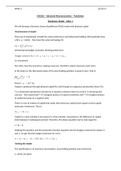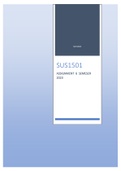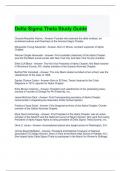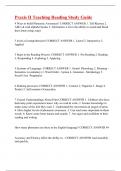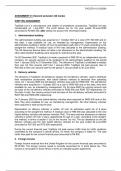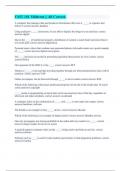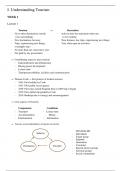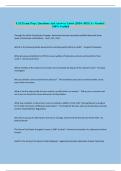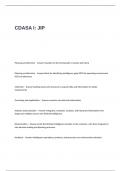Week 3: 22/02/21
ECN302 – Advanced Macroeconomics – Pandemics
Pandemics Model - Video 1
We will develop a Dynamic General Equilibrium (DGE) model with physical capital.
-Environment of model
There are N households, all with the same preferences and initial asset holding. All households have
a firm, yt = AtF(kt) – they have the same technology (F).
Intertemporal budget constraint showing preferences:
it is investment.
The LHS is how the economy is making resources. The RHS is where resources come from.
In the long run, the discounted value of the asset holding position is equal to zero. That is:
Output is produced through physical capital (k t) and through an exogenous productivity factor (A t).
F is a neoclassical production function as it assumes constant returns to scale & is increasing and
concave – this means that F’>0 (marginal product of capital is positive) and F’’<0 (marginal product
of capital increases at a negative rate).
There is a law of motion of capital that states that tomorrow capital stock equals current capital
stock plus investment. That is:
Capital is a stock variable & investment is a flow variable. Investment is the difference in capital
stock between 2 subsequent periods. Therefore, the above equation can be rearranged to:
it = kt+1 - kt
Subbing this equation and the production function equation into the budget constraint to replace it
and yt, we get that the budget constraint for t≥0 is:
-Solving the model
The specification is to maximise consumption, asset holding position and investment.
a-1 and k0 are given.
, Week 3: 22/02/21
There are 3 steps to solving the model:
1) Form a Lagrangian function
2) Take the FOCs
3) Combine equations to eliminate the Lagrange multiplier.
1) Form a Lagrangian function:
2) FOCs for t≥0:
3) Combine equations to eliminate the Lagrange multiplier:
Using the ct equation, we know that:
λt = βtu’(ct) and λt+1 = βtu’(ct+1)
Sub these two equations into the at and kt+1 equations to replace λt and λt+1. This gives us:
Equate the first 2 equations and cancel out the common terms to get:
This is the no-arbitrage condition. Savings can either go in financial assets or in physical capital. This
condition says that in equilibrium, there is no incentive to invest in any particular asset, therefore in
equilibrium, the growth rate of return on a financial asset must be equal to the growth rate of return
on physical capital.
When we remove the 1 from both sides of this equation we get:
This tells us that in equilibrium, the rate of return is equal to the marginal product of capital.
ECN302 – Advanced Macroeconomics – Pandemics
Pandemics Model - Video 1
We will develop a Dynamic General Equilibrium (DGE) model with physical capital.
-Environment of model
There are N households, all with the same preferences and initial asset holding. All households have
a firm, yt = AtF(kt) – they have the same technology (F).
Intertemporal budget constraint showing preferences:
it is investment.
The LHS is how the economy is making resources. The RHS is where resources come from.
In the long run, the discounted value of the asset holding position is equal to zero. That is:
Output is produced through physical capital (k t) and through an exogenous productivity factor (A t).
F is a neoclassical production function as it assumes constant returns to scale & is increasing and
concave – this means that F’>0 (marginal product of capital is positive) and F’’<0 (marginal product
of capital increases at a negative rate).
There is a law of motion of capital that states that tomorrow capital stock equals current capital
stock plus investment. That is:
Capital is a stock variable & investment is a flow variable. Investment is the difference in capital
stock between 2 subsequent periods. Therefore, the above equation can be rearranged to:
it = kt+1 - kt
Subbing this equation and the production function equation into the budget constraint to replace it
and yt, we get that the budget constraint for t≥0 is:
-Solving the model
The specification is to maximise consumption, asset holding position and investment.
a-1 and k0 are given.
, Week 3: 22/02/21
There are 3 steps to solving the model:
1) Form a Lagrangian function
2) Take the FOCs
3) Combine equations to eliminate the Lagrange multiplier.
1) Form a Lagrangian function:
2) FOCs for t≥0:
3) Combine equations to eliminate the Lagrange multiplier:
Using the ct equation, we know that:
λt = βtu’(ct) and λt+1 = βtu’(ct+1)
Sub these two equations into the at and kt+1 equations to replace λt and λt+1. This gives us:
Equate the first 2 equations and cancel out the common terms to get:
This is the no-arbitrage condition. Savings can either go in financial assets or in physical capital. This
condition says that in equilibrium, there is no incentive to invest in any particular asset, therefore in
equilibrium, the growth rate of return on a financial asset must be equal to the growth rate of return
on physical capital.
When we remove the 1 from both sides of this equation we get:
This tells us that in equilibrium, the rate of return is equal to the marginal product of capital.


